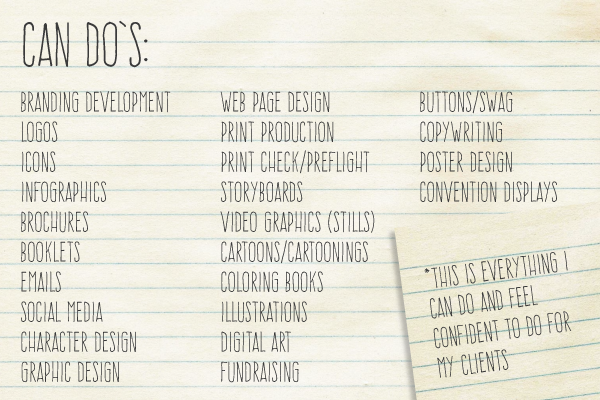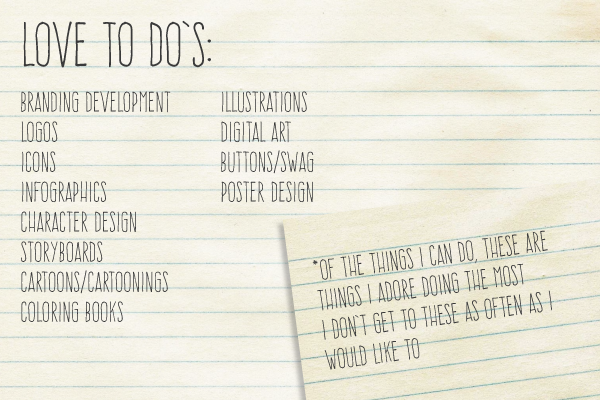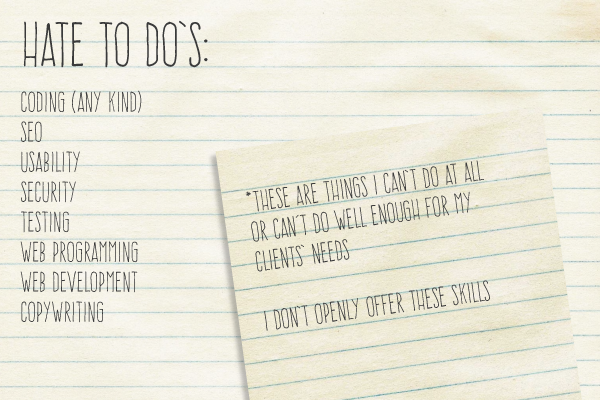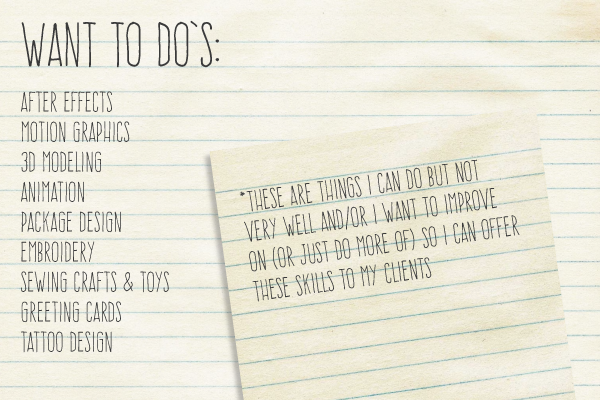There is nothing dirtier, or more insulting, to a designer or artist that does their craft for a living than to call them a "hobbyist." Full stop. No really. There are many things you could call them that may or may not be true, but calling them a hobbyist dilutes all their education and experience into a flavorless goulash of mediocrity. Let's be honest here for a moment. Not everyone can be an artist in the sense of a financially successful one. Yes, everyone can be an artist in one aspect or another. But your child's crayon drawings are not the next Picasso or Banksy. Sorry parents. Even if they wish really, REALLY, hard they won't make it to that level without a butt-load of work and dedication.
Hobby vs. Career
There's an old saying that goes "Make your hobby your career and never work another day again." It's a nice sentiment to give someone who is stuck in a dead-end job some glimmer of hope that there is something better just beyond the horizon. But how many people actually seriously attempt to make what they love their everyday job? I'll tell you, a hell of a lot less than you'd think. Because the big reveal is there's even more work to do when you attempt to make what you love into a real money earning endeavor. It's a lot more work trying to convince other people to buy what you're selling, and still love to do it even when no one is buying.
A hobby is something a person does for leisure. That seems much more relaxing than searching for new clients, producing your own work when projects are slow, or attending all the seminars and events to keep up with networking. Even if you put a lot of time to ascend your skill level to the max, it's still something you do for an escape from the everyday. Moving that into the career realm, and there's a lot less relaxing involved. Making projects for yourself might give a much needed break to client work, but only a handful can live off their personal projects.
They can because they are the best and people want their work. Did they start as hobbyists and work their way up into careers? Possibly, but they didn't start at the middle ground and take the short climb to the top. What they might not show is all the rejected work they sent out in the early years. Even in the face of constant adversity, they kept pushing and pushing hard. Eventually, after years or even decades later, they make it. Anyone doing this as a hobby would eventually give up pushing it that hard and go back doing it for fun. Or be so turned off by the backlash that they shake off the craft completely. Rejection weeds out the weak.
Being Taken Seriously
I have no ill towards people that do art in any form as a hobby. I hope they enjoy it and progress their skill as far as they want to pursue it. However, the creatives that have chosen to take the professional route should be held on a higher ground. It's not being an elitist to expect to be held to a higher standard as we take what we do more seriously. This is our living. Most months, it's hand-to-mouth in regards to money and projects. I will politely correct anyone that labels me as a hobbyist and not what I actually am: a freelance graphic artist.
I've spent over a decade perfecting, and still evolving, my skill set to produce the best work I can for clients. I've been drawing since I was two years old and still crave to keep drawing everyday. And I have spent the last few years learning how to better run and maintain my business because I don't want to work in a sea of cubicles anymore. This is the most stressful and time consuming hobby if there ever was one. Calling all this work just a "hobby" doesn't do my efforts justice. It undermines the time, money, blood, sweat, tears, and hair-pulling into an easy to dismiss lark that anyone with basic motor skills can do. If anyone can do this, why aren't they?
To put it in simple terms, not everyone has the courage to. That's not a jab at people that have chosen not to make their hobbies their careers. Some people prefer to keep their hobbies just that, which is OK. Others can't handle the idea of extra work or the risks of rejection and failure. That takes the fun out of it. Hobbies are meant to be fun. I do have fun with my work, but I won't lie and say I'm grinning like a cheshire cat when modifying a logo for the fiftieth time. It's a different mental presence that is required to dig deep and keep working even when you're mentally spent.
All About Passion
Hobbies and careers have the same base to their souls: passion. Whatever gives you joy and pleasure stems from the drive to do it in the first place. Keep building your cabinets, blowing your glass, molding your clay, drawing your sketch, sewing your quilt, or whatever your heart wants to do. But please, don't call creative professionals hobbyists. We only play hobbyists on television.
Focus is what makes skills sharp, talent shine, and projects complete. The ability to know what to focus on and when is imperative to getting things done efficiently, thoroughly, and with a strong force behind it. But when you're the only member of the team doing all the work, it becomes overwhelming. There are aspects that you can do amazingly and other things you can't do at all. So what do you do when you're flying solo on a huge project with lots of parts that you're not comfortable with? Well, before you get to that point you should look at yourself (and your skills) and ask:
- What can I do?
- What do I love doing?
- What do I hate doing?
- What do I want to improve?
Answering these questions will help a great deal when presenting yourself to clients and selecting projects. In the years I've worked in both office environments with other team members and working for myself, I've discovered a few things. First off, everyone does something different in regards to a single project. A few people might be good designers but one is better at making logos, so they got that job. Only one person can code, so they got that job. A few can brainstorm and present well, so those jobs were divided among them. There is some overlap and people can float, but it is a group effort with many hands working together. When you freelance, there might only be your two hands.
After working for a while as a freelancer, there were projects that came up that I could do but I wasn't very excited about them. They involved companies that were too corporate for my flavor of design. But that's the name of the game sometimes. Doing work to pay the bills is going to happen but it isn't satisfying. When the fun projects come along they are often rare and very quick to wrap up. Much like watching fireworks for five minutes. As the skill list grew, I noticed those firework projects were coming in even less than before.
I recently attended an AIGA event at a local branding/screen printing company and art gallery BLDG. They have a flavor for urban street art and present themselves as more of a boutique of branding and design. They don't offer anything web related, do wall murals around town, and they aren't a one-stop-shop for work because they don't want to be one. Their concept blew my mind! With a staff of less than a dozen people, they had a successful shop with amazing work that you could see the love behind. I decided to take their approach and apply it to my company. I've decided to narrow down what I offer so I can find a better niche for myself and the strengths of my skills and be able to do more of what I love.
Can Do's
First I had to figure out what those where. So I decided to make some lists. I love lists. My first list was all the skills I had, things I have done, things I was confident doing, things that were easy to do for me. This is my list of Can Do's:
It's a pretty long list of things. Aside from all under the blanket of design, there is no focus to anything. The amount of items surprised me after I wrote everything down.
Love to Do's
Next was the list of things I loved to do. Using the first list as a starting point, I picked out the items that I loved to do. These were the elements that I get excited about and I know I excel at. Here is my list of Love to Do's:
A much shorter list for sure. I started to see a pattern here of things I enjoyed doing the most. There is a lot of visual items, such as cartoons, logos, icons, and illustration. These are at the core of my passions. It was great to see that and allow me to focus on presenting myself more in this direction rather than with everything else I could do.
Hate to Do's
Now that I covered the love part, time for the hate part. This list includes items from my Can Do section and also includes things clients have asked me to do in the past. These also include skills that I can do but not well enough to say I can. I don't offer some of these items openly, as I don't feel confident in my abilities. Here are my Hate to Do's:
A much shorter list this time. It also displays for me what I want to avoid doing. In my case, anything related to code. I know enough X/HTML to get by, but it's a skill set that I never mastered. More importantly, after I tried to learn it I never wanted to be a master in. It just isn't my cup of tea.
Want to Do's
Finally was my dream list. This list has items that I can do but I'm out of practice in. It also has items I want to learn and focus on as new skills to present to my clients. Here are my Want to Do's:
This list supports my Love to Do's list with things related to playful things, like toys and greeting cards.
Writing these lists provided so much clarity to where my passions are and what areas I want to step away from. It won't happen overnight, but I now have better focus on where to put my force.



